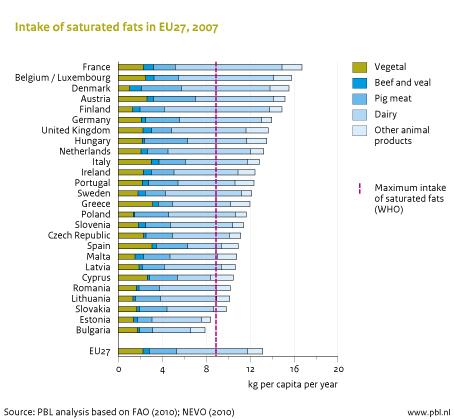The protein puzzle: the consumption and production of meat, dairy and fish in the European Union
Average consumption of meat, dairy and fish has increased strongly over the last fifty years in the European Union. Today’s consumption is twice the world average. Current preferences of European consumers lead to a range of negative impacts, such as extensive land use (also outside Europe), biodiversity loss and human health risks.
Therefore, the possible solutions for these issues need to be considered within an EU context, and are becoming more urgent with animal-protein consumption in non-Western countries increasing as a result of the growing world population and rising prosperity. Solutions may be found either in a reduction in the consumption of meat, dairy and fish, or in improvements in animal husbandry and fisheries. For the EU to achieve a more sustainable livestock production and fisheries, it would be vital to utilise the coming reform of the Common Agricultural Policy and the Common Fisheries Policy.
In the report 'The protein puzzle. The consumption and production of meat, dairy and fish in the European Union', released today by the PBL Netherlands Environmental Assessment Agency, researchers have assessed the consequences of the production and consumption of animal proteins for human health and the environment. Moreover, the PBL report sketches the options for reducing these impacts in a European context. With this study, the PBL aims to contribute to the societal discussion and policy process concerning protein consumption, by providing relevant facts and figures, including indications of uncertainties.
European livestock production: sizeable land area and greenhouse gas emissions
Animal-protein production, generally, is inefficient compared to that of vegetable protein. To produce one kilogram of protein from cereals requires the use of 20 m2 of land. For poultry meat and milk this is 35 m2, for pork 60 m2 and for beef over 100 m2. In the EU, about two thirds of the total agricultural area is used in livestock production. For feed, the European livestock production depends on the import of soy, the production of which requires agricultural land mostly in Brazil and Argentina. Furthermore, livestock production is responsible for around 10% of EU greenhouse gas emissions. Significant increases are expected in the global demand for animal products and a corresponding demand for feed and fishfeed, in the coming decades, as a result of a growing global population and increasing prosperity. To meet this additional demand, worldwide, nature areas will be converted into agricultural land, and competition over scarce resources such as water and phosphate (for fertilisers) will increase.
Fisheries: large impact on marine biodiversity
Fisheries also have their problems. Many marine fish populations are overexploited and fisheries have a large impact on marine biodiversity. Despite new fishing grounds for European fishermen, fish stocks are recovering slowly and catches in the main EU fishing areas continue to decline. In the EU, the aquacultural production hardly has increased over the last 10 years.
Reduced consumption of meat and dairy
The European food system could become more sustainable, both on the demand side (consumers) and on the supply side (producers). A decrease in the consumption of meat and dairy would require less agricultural land. In such a case, greenhouse gas emissions also would be lower, and effects on human health would be positive. In addition, reductions in food losses would be beneficial to the environment. Currently, however, there are no policies aimed at changing consumption patterns.
Shift towards sustainable livestock production
There are a number of ways for livestock production to become more sustainable. A more efficient production, for example crop yield increases or improved conversion of feed into animal products, would lead to a reduction in land area needed and in lower greenhouse gas emissions. However, such an efficient production may lead to local problems, such as overfertilisation, reduced animal welfare and an increased use of antibiotics.
The Common Agricultural Policy (CAP) may contribute to a shift towards a more sustainable livestock production. EU investment subsidies to improve competitiveness could be employed to stimulate a livestock production that is efficient, animal friendly and free of antibiotics. The development of such improved husbandry systems, would also require certain innovations. The EU could slow down the loss of biodiversity caused by intensive agriculture by remunerating farmers for landscape management, and by providing additional support to farmers in areas of extensive, High Nature Value farmland.
The EU could increase their focus on the development of sustainable aquaculture
The EU Common Fisheries Policy could make fisheries more sustainable by adapting the quota system and by preventing the by-catch and discarding of fish. The introduction of the concept of ‘maximum sustainable yield’ (MSY) to restore fish stocks and improve the position of local fisheries also will contribute. Certification could be an impulse prompting economic and ecological improvements in fisheries. The EU could increase their focus on the development of sustainable aquaculture, in which fish mainly eat plant-based feed rather than fishmeal made from wild wild-caught fish.
Shift towards quality
Many of the measures mentioned above will lead to additional costs for farmers and fishermen, whose incomes currently are already low. The EU could contribute to a solution to this dilemma by helping farmers and fishermen to make the transition towards a more sustainable production of meat, fish and dairy with a higher added value. This would also involve retailers being prepared to put these products on offer, and consumers buying these products against the corresponding higher prices. Price levels would then depend on the ambition level.

Authors
Specifications
- Publication title
- The protein puzzle: the consumption and production of meat, dairy and fish in the European Union
- Publication date
- 28 April 2011
- Publication type
- Publicatie
- Publication language
- Engels
- Product number
- 92581